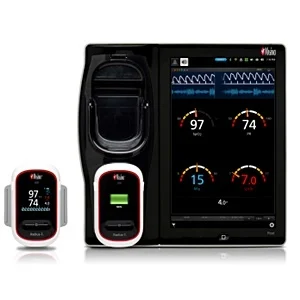Radius-7 is the First Wearable, Tetherless, Noninvasive rainbow® Monitor
Masimo has announced FDA 510(k) clearance for Radius-7® – the first and only wearable, tetherless, noninvasive rainbow® monitor. Radius-7, which connects to the Root® patient monitoring and connectivity platform, is now available in the U.S. with breakthrough Masimo rainbow® technology. With this clearance, Radius-7 with Root now enables non-invasive monitoring of more than 10 parameters, including, for the first time in a wearable device, total hemoglobin (SpHb), a breakthrough measurement that noninvasively and continuously measures hemoglobin concentration.
SpHb monitoring may provide additional insight to the directional trend of hemoglobin between invasive blood samplings – when the SpHb trend is stable and the clinician may otherwise think hemoglobin is decreasing; when SpHb trend is rising and the clinician may otherwise think hemoglobin is not rising fast enough; or when the SpHb trend is decreasing and the clinician may otherwise think hemoglobin is stable. SpHb may thus help clinicians make more timely and informed decisions, and has been shown to help clinicians provide more timely blood transfusions* and reduce blood transfusions in cases such as neurosurgery and orthopedic surgery.1,2
Professor Christer Svensen, Professor of Anesthesiology and Intensive Care at the Karolinska Institute inStockholm, Sweden, who has been using Radius-7 as part of a research study, commented, “We are currently performing a noninvasive continuous study monitoring respiratory rate, heart rate and saturation for all patients admitted to a surgical ward. Additionally, we are monitoring SpHb for selected postsurgical patients, which can be extremely beneficial because it can provide insight into hemoglobin trends between invasive blood samplings. Such insight may lead clinicians to confirm trends by performing blood draws sooner than they might otherwise have done, which may then suggest the need to intervene.”
For the first time, it is possible to offer patients freedom of movement while providing such important monitoring, and studies have shown that patient mobility is a key factor in more rapid patient recovery.3,4 When monitoring ambulating patients, Radius-7 communicates to Root at the bedside and thereby to Masimo Patient SafetyNet™ to alert clinicians of critical changes in oxygen saturation, pulse rate, respiration, and hemoglobin, among other parameters. Radius-7 is lightweight, weighing only 0.34 lbs, and attaches to the arm, thus allowing untethered monitoring whether a patient is in or out of bed – which also reduces the need for nursing assistance, as there is no need to disconnect from or reconnect to a bedside monitor. Each Radius-7 comes with two “hot-swappable” rechargeable battery modules (one with the patient, one charging), each with a battery life of 12 hours, minimizing monitoring interruption.
“Never before could patients be monitored for such key parameters as continuous SpHb, which can help clinicians make more timely and informed blood management decisions, while patients are fully mobile. Previous wearable patient monitors were hampered by a limited range of measurements and false alarms due to motion,” said Joe Kiani, Founder and CEO of Masimo. “Root with Radius-7 with rainbow SET, coupled with Patient SafetyNet for mobile clinician notification, is now an even more versatile and powerful monitoring system, all while promoting freedom of patient movement and quicker recovery times.”
*Clinical decisions regarding red blood cell transfusions should be based on the clinician’s judgment considering, among other factors: patient condition, continuous SpHb monitoring, and laboratory diagnostic tests using blood samples.
References
| 1. | Ehrenfeld JM et al. J Blood Disorders Transf. 2014. 5:9. 2. | ||
| 2. | Awada WN et al. J Clin Monit Comput. 2015 Feb 4. | ||
| 3. | Needham D, Korupolu R, Zanni J, Pradhan P, Colantuoni E, Palmer J, Brower R, Fan E. "Early Physical Medicine and Rehabilitation for Patients With Acute Respiratory Failure: A Quality Improvement Project."Archives of Physical Medicine and Rehabilitation. Vol 91, Issue 4, PP 536–542, April 2010. | ||
| 4. | Ronnenbaum J, Weir J, Hilsabeck T. Earlier mobilization decreases length of stay in the intensive care unit. J Acute Care Phys Ther. 2012;3(2):204-210. | ||










